Intercultural Communication Observation
VerifiedAdded on 2020/03/16
|16
|3408
|59
AI Summary
This assignment focuses on the importance of observation in intercultural communication. It emphasizes noticing subtle behavioral patterns and speech styles within different cultures to gain insights into their communication norms. The text highlights how curiosity and careful observation can equip individuals with the tools to navigate intercultural interactions effectively.
Contribute Materials
Your contribution can guide someone’s learning journey. Share your
documents today.
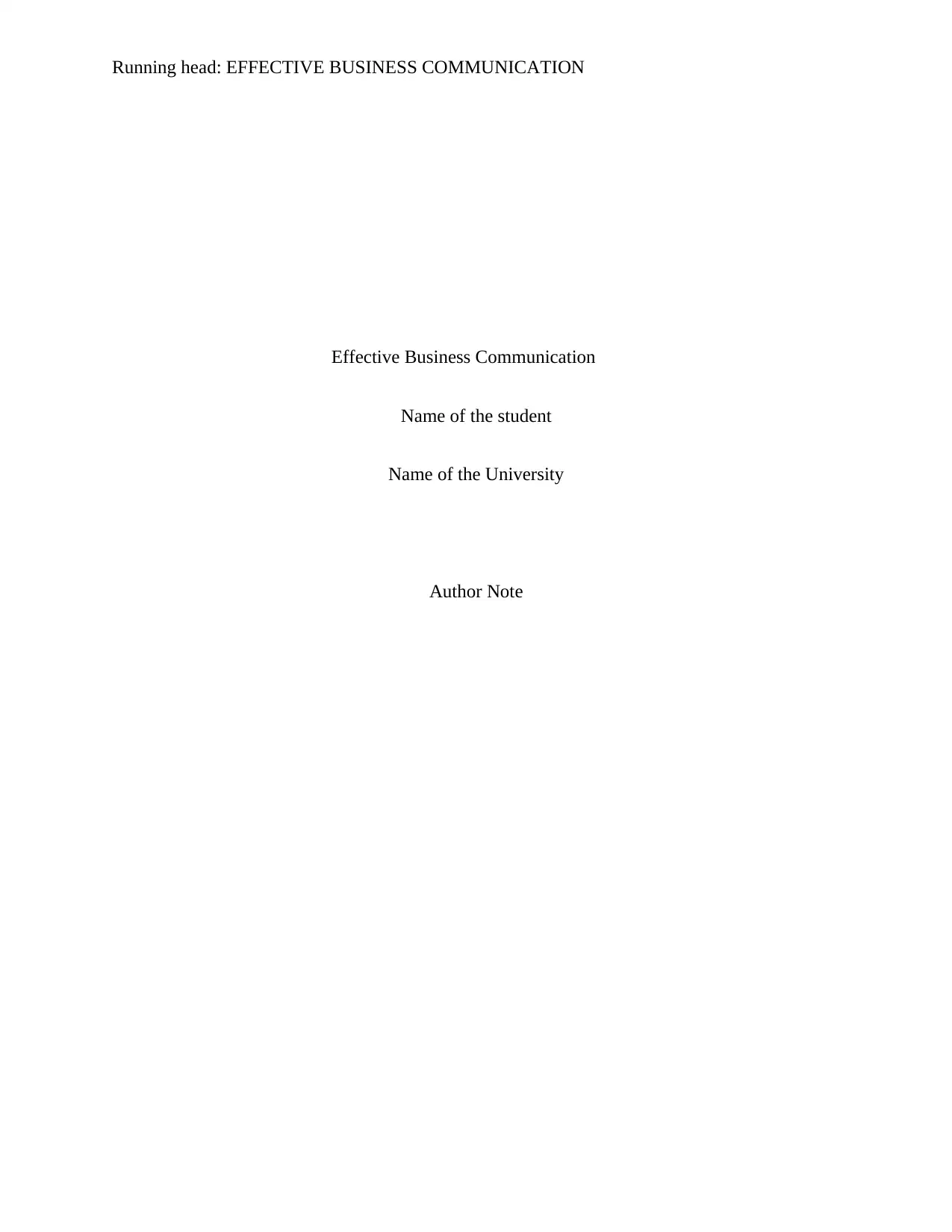
Running head: EFFECTIVE BUSINESS COMMUNICATION
Effective Business Communication
Name of the student
Name of the University
Author Note
Effective Business Communication
Name of the student
Name of the University
Author Note
Secure Best Marks with AI Grader
Need help grading? Try our AI Grader for instant feedback on your assignments.
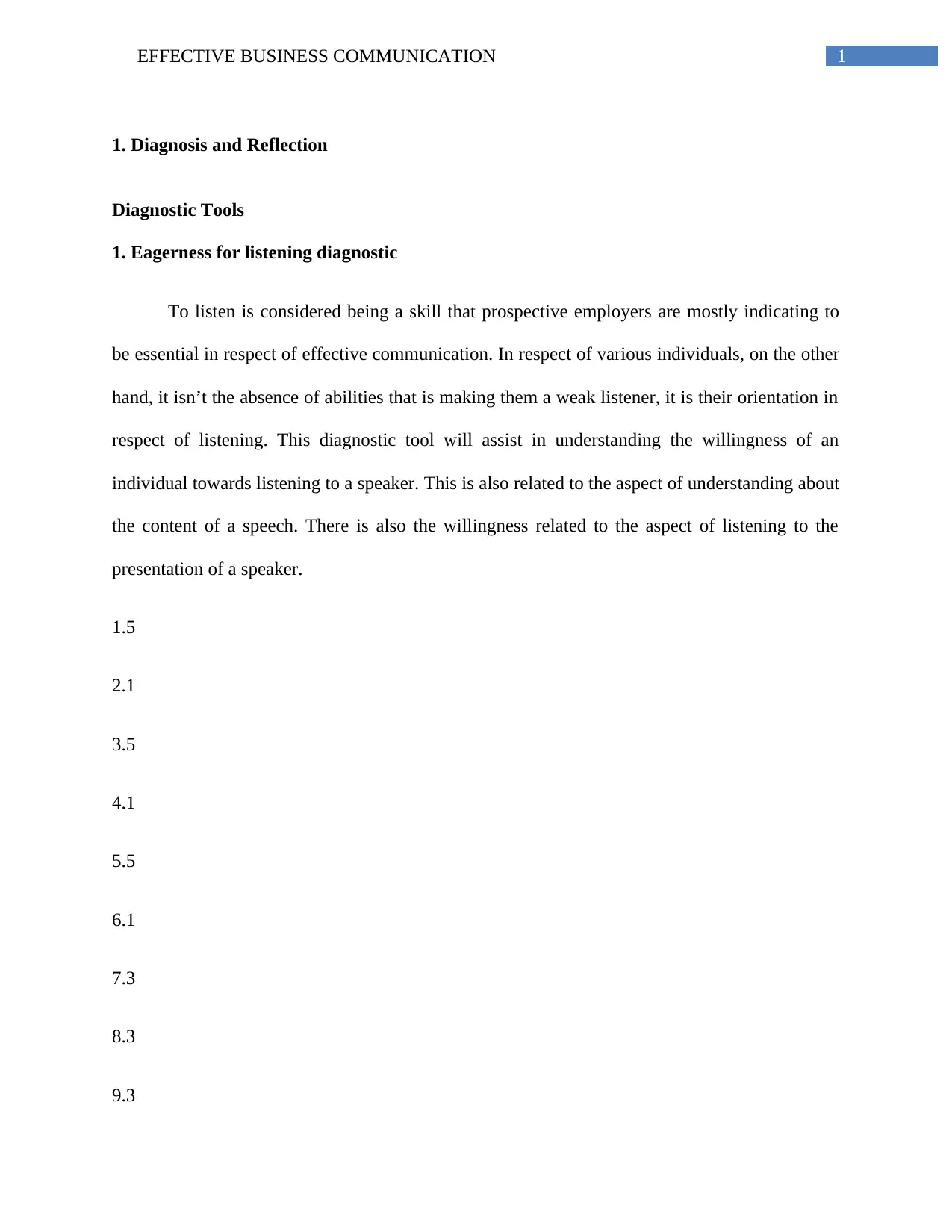
1EFFECTIVE BUSINESS COMMUNICATION
1. Diagnosis and Reflection
Diagnostic Tools
1. Eagerness for listening diagnostic
To listen is considered being a skill that prospective employers are mostly indicating to
be essential in respect of effective communication. In respect of various individuals, on the other
hand, it isn’t the absence of abilities that is making them a weak listener, it is their orientation in
respect of listening. This diagnostic tool will assist in understanding the willingness of an
individual towards listening to a speaker. This is also related to the aspect of understanding about
the content of a speech. There is also the willingness related to the aspect of listening to the
presentation of a speaker.
1.5
2.1
3.5
4.1
5.5
6.1
7.3
8.3
9.3
1. Diagnosis and Reflection
Diagnostic Tools
1. Eagerness for listening diagnostic
To listen is considered being a skill that prospective employers are mostly indicating to
be essential in respect of effective communication. In respect of various individuals, on the other
hand, it isn’t the absence of abilities that is making them a weak listener, it is their orientation in
respect of listening. This diagnostic tool will assist in understanding the willingness of an
individual towards listening to a speaker. This is also related to the aspect of understanding about
the content of a speech. There is also the willingness related to the aspect of listening to the
presentation of a speaker.
1.5
2.1
3.5
4.1
5.5
6.1
7.3
8.3
9.3
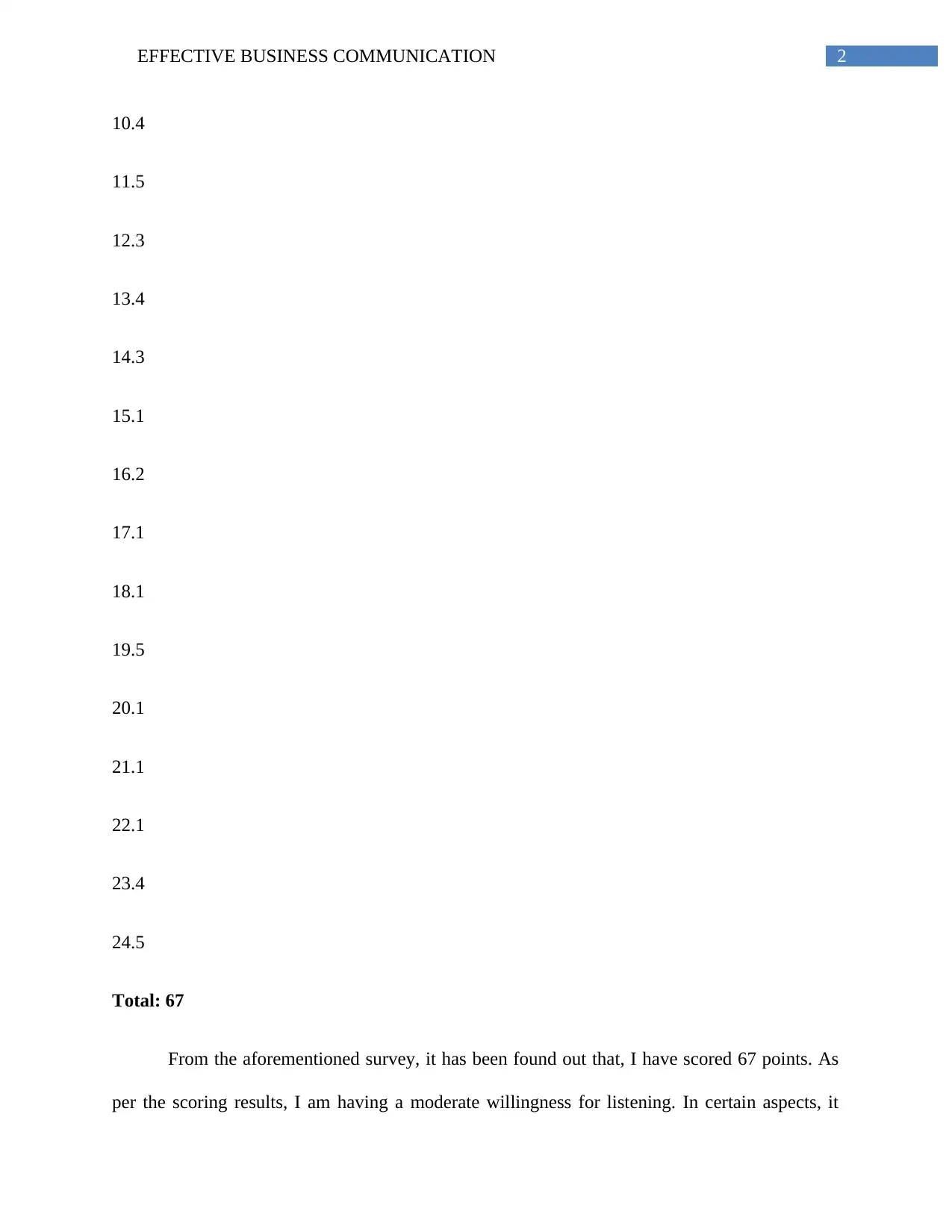
2EFFECTIVE BUSINESS COMMUNICATION
10.4
11.5
12.3
13.4
14.3
15.1
16.2
17.1
18.1
19.5
20.1
21.1
22.1
23.4
24.5
Total: 67
From the aforementioned survey, it has been found out that, I have scored 67 points. As
per the scoring results, I am having a moderate willingness for listening. In certain aspects, it
10.4
11.5
12.3
13.4
14.3
15.1
16.2
17.1
18.1
19.5
20.1
21.1
22.1
23.4
24.5
Total: 67
From the aforementioned survey, it has been found out that, I have scored 67 points. As
per the scoring results, I am having a moderate willingness for listening. In certain aspects, it
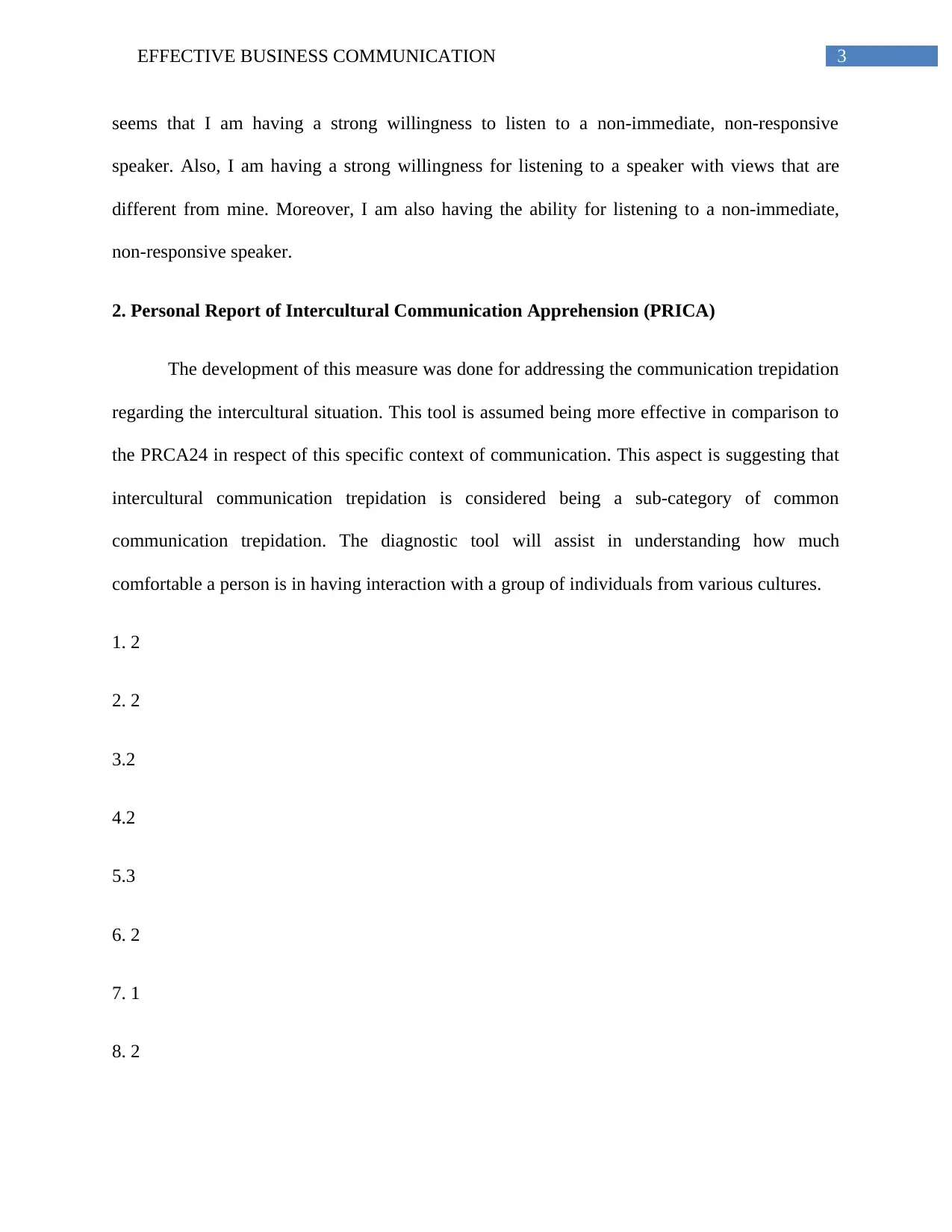
3EFFECTIVE BUSINESS COMMUNICATION
seems that I am having a strong willingness to listen to a non-immediate, non-responsive
speaker. Also, I am having a strong willingness for listening to a speaker with views that are
different from mine. Moreover, I am also having the ability for listening to a non-immediate,
non-responsive speaker.
2. Personal Report of Intercultural Communication Apprehension (PRICA)
The development of this measure was done for addressing the communication trepidation
regarding the intercultural situation. This tool is assumed being more effective in comparison to
the PRCA24 in respect of this specific context of communication. This aspect is suggesting that
intercultural communication trepidation is considered being a sub-category of common
communication trepidation. The diagnostic tool will assist in understanding how much
comfortable a person is in having interaction with a group of individuals from various cultures.
1. 2
2. 2
3.2
4.2
5.3
6. 2
7. 1
8. 2
seems that I am having a strong willingness to listen to a non-immediate, non-responsive
speaker. Also, I am having a strong willingness for listening to a speaker with views that are
different from mine. Moreover, I am also having the ability for listening to a non-immediate,
non-responsive speaker.
2. Personal Report of Intercultural Communication Apprehension (PRICA)
The development of this measure was done for addressing the communication trepidation
regarding the intercultural situation. This tool is assumed being more effective in comparison to
the PRCA24 in respect of this specific context of communication. This aspect is suggesting that
intercultural communication trepidation is considered being a sub-category of common
communication trepidation. The diagnostic tool will assist in understanding how much
comfortable a person is in having interaction with a group of individuals from various cultures.
1. 2
2. 2
3.2
4.2
5.3
6. 2
7. 1
8. 2
Secure Best Marks with AI Grader
Need help grading? Try our AI Grader for instant feedback on your assignments.
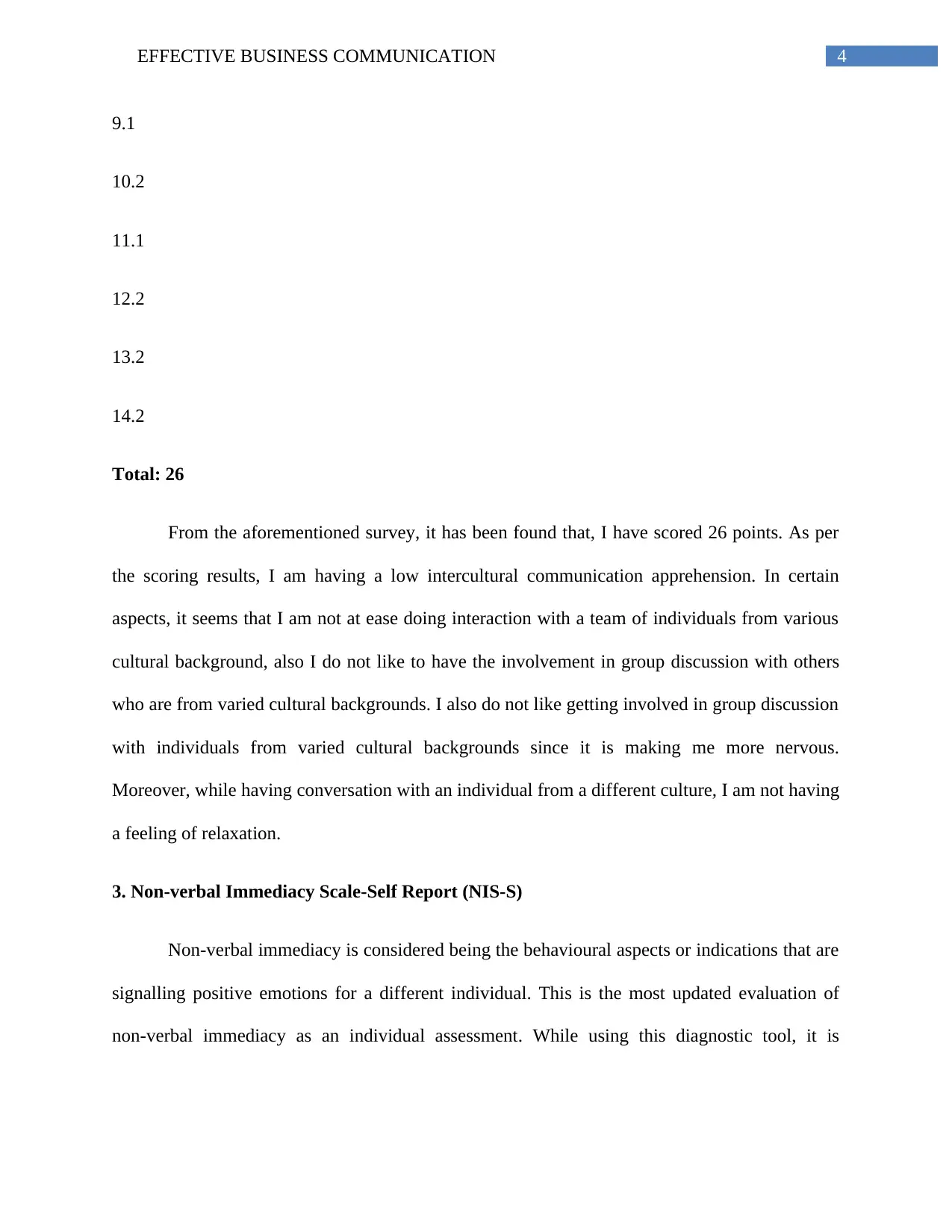
4EFFECTIVE BUSINESS COMMUNICATION
9.1
10.2
11.1
12.2
13.2
14.2
Total: 26
From the aforementioned survey, it has been found that, I have scored 26 points. As per
the scoring results, I am having a low intercultural communication apprehension. In certain
aspects, it seems that I am not at ease doing interaction with a team of individuals from various
cultural background, also I do not like to have the involvement in group discussion with others
who are from varied cultural backgrounds. I also do not like getting involved in group discussion
with individuals from varied cultural backgrounds since it is making me more nervous.
Moreover, while having conversation with an individual from a different culture, I am not having
a feeling of relaxation.
3. Non-verbal Immediacy Scale-Self Report (NIS-S)
Non-verbal immediacy is considered being the behavioural aspects or indications that are
signalling positive emotions for a different individual. This is the most updated evaluation of
non-verbal immediacy as an individual assessment. While using this diagnostic tool, it is
9.1
10.2
11.1
12.2
13.2
14.2
Total: 26
From the aforementioned survey, it has been found that, I have scored 26 points. As per
the scoring results, I am having a low intercultural communication apprehension. In certain
aspects, it seems that I am not at ease doing interaction with a team of individuals from various
cultural background, also I do not like to have the involvement in group discussion with others
who are from varied cultural backgrounds. I also do not like getting involved in group discussion
with individuals from varied cultural backgrounds since it is making me more nervous.
Moreover, while having conversation with an individual from a different culture, I am not having
a feeling of relaxation.
3. Non-verbal Immediacy Scale-Self Report (NIS-S)
Non-verbal immediacy is considered being the behavioural aspects or indications that are
signalling positive emotions for a different individual. This is the most updated evaluation of
non-verbal immediacy as an individual assessment. While using this diagnostic tool, it is

5EFFECTIVE BUSINESS COMMUNICATION
essential to do the recognition that the differentiating factor in these individual assessments
within the females as well as males is statistically and socially important.
1. 2
2.2
3.2
4.3
5.2
6.2
7.2
8.1
9.2
10.2
11.2
12.1
13.1
14.2
15.2
16.2
essential to do the recognition that the differentiating factor in these individual assessments
within the females as well as males is statistically and socially important.
1. 2
2.2
3.2
4.3
5.2
6.2
7.2
8.1
9.2
10.2
11.2
12.1
13.1
14.2
15.2
16.2
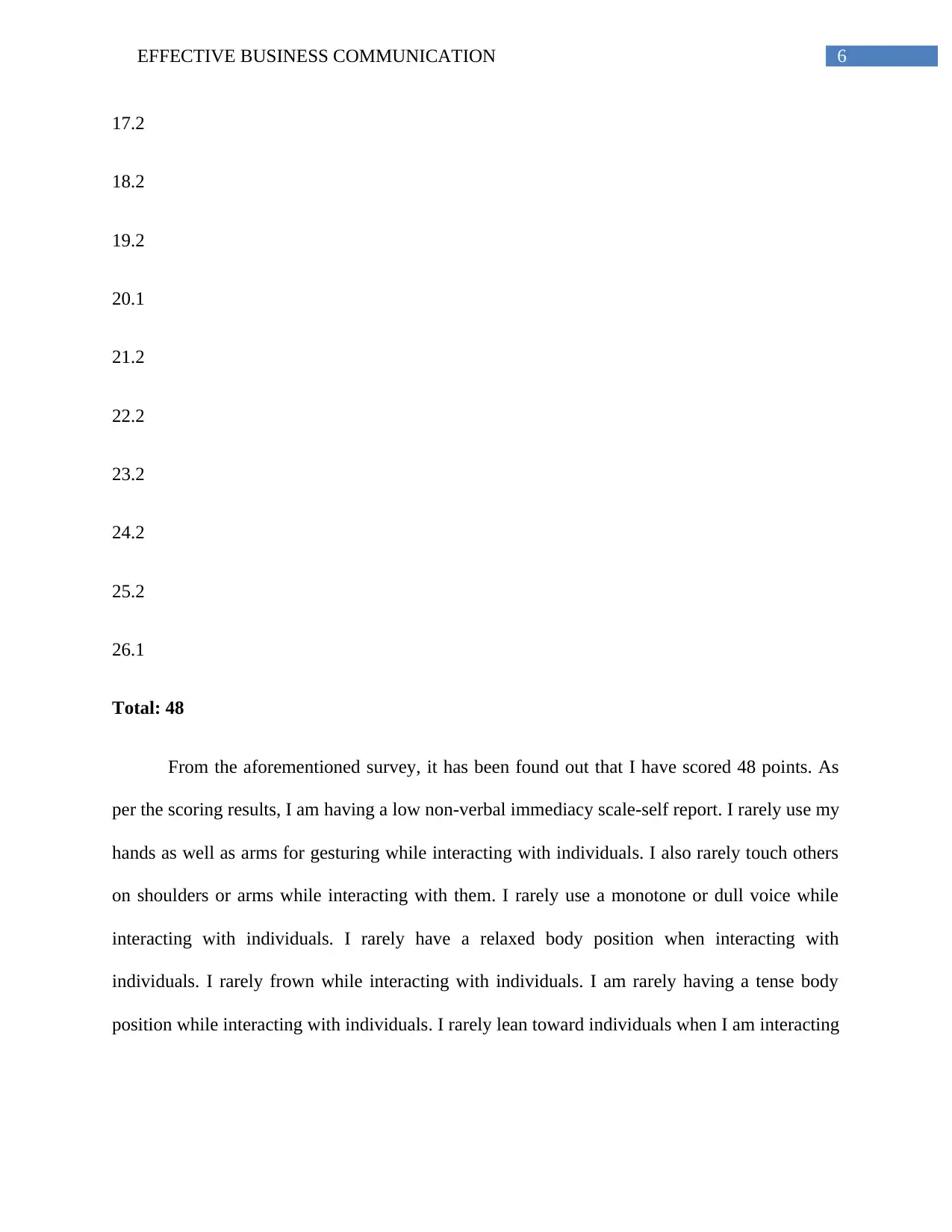
6EFFECTIVE BUSINESS COMMUNICATION
17.2
18.2
19.2
20.1
21.2
22.2
23.2
24.2
25.2
26.1
Total: 48
From the aforementioned survey, it has been found out that I have scored 48 points. As
per the scoring results, I am having a low non-verbal immediacy scale-self report. I rarely use my
hands as well as arms for gesturing while interacting with individuals. I also rarely touch others
on shoulders or arms while interacting with them. I rarely use a monotone or dull voice while
interacting with individuals. I rarely have a relaxed body position when interacting with
individuals. I rarely frown while interacting with individuals. I am rarely having a tense body
position while interacting with individuals. I rarely lean toward individuals when I am interacting
17.2
18.2
19.2
20.1
21.2
22.2
23.2
24.2
25.2
26.1
Total: 48
From the aforementioned survey, it has been found out that I have scored 48 points. As
per the scoring results, I am having a low non-verbal immediacy scale-self report. I rarely use my
hands as well as arms for gesturing while interacting with individuals. I also rarely touch others
on shoulders or arms while interacting with them. I rarely use a monotone or dull voice while
interacting with individuals. I rarely have a relaxed body position when interacting with
individuals. I rarely frown while interacting with individuals. I am rarely having a tense body
position while interacting with individuals. I rarely lean toward individuals when I am interacting
Paraphrase This Document
Need a fresh take? Get an instant paraphrase of this document with our AI Paraphraser
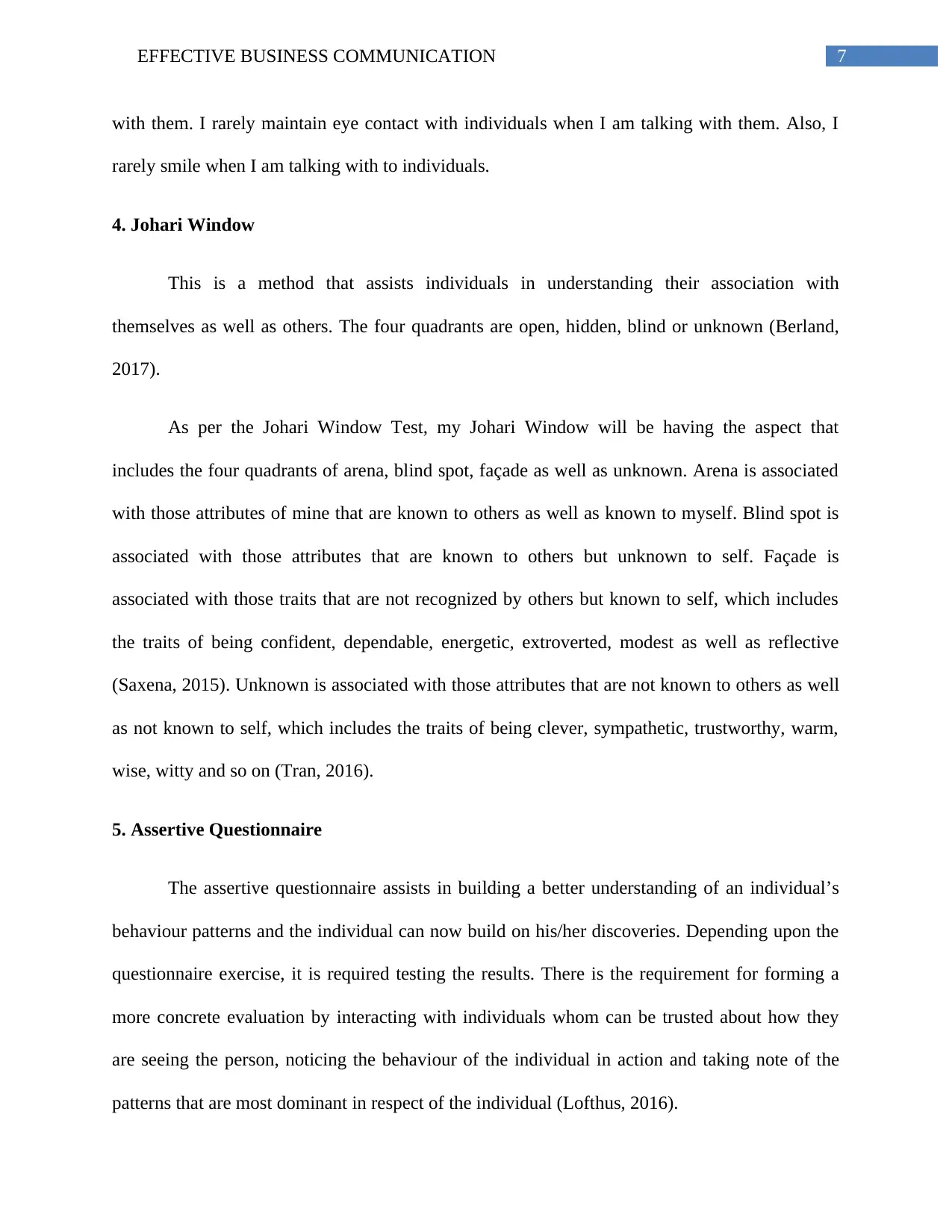
7EFFECTIVE BUSINESS COMMUNICATION
with them. I rarely maintain eye contact with individuals when I am talking with them. Also, I
rarely smile when I am talking with to individuals.
4. Johari Window
This is a method that assists individuals in understanding their association with
themselves as well as others. The four quadrants are open, hidden, blind or unknown (Berland,
2017).
As per the Johari Window Test, my Johari Window will be having the aspect that
includes the four quadrants of arena, blind spot, façade as well as unknown. Arena is associated
with those attributes of mine that are known to others as well as known to myself. Blind spot is
associated with those attributes that are known to others but unknown to self. Façade is
associated with those traits that are not recognized by others but known to self, which includes
the traits of being confident, dependable, energetic, extroverted, modest as well as reflective
(Saxena, 2015). Unknown is associated with those attributes that are not known to others as well
as not known to self, which includes the traits of being clever, sympathetic, trustworthy, warm,
wise, witty and so on (Tran, 2016).
5. Assertive Questionnaire
The assertive questionnaire assists in building a better understanding of an individual’s
behaviour patterns and the individual can now build on his/her discoveries. Depending upon the
questionnaire exercise, it is required testing the results. There is the requirement for forming a
more concrete evaluation by interacting with individuals whom can be trusted about how they
are seeing the person, noticing the behaviour of the individual in action and taking note of the
patterns that are most dominant in respect of the individual (Lofthus, 2016).
with them. I rarely maintain eye contact with individuals when I am talking with them. Also, I
rarely smile when I am talking with to individuals.
4. Johari Window
This is a method that assists individuals in understanding their association with
themselves as well as others. The four quadrants are open, hidden, blind or unknown (Berland,
2017).
As per the Johari Window Test, my Johari Window will be having the aspect that
includes the four quadrants of arena, blind spot, façade as well as unknown. Arena is associated
with those attributes of mine that are known to others as well as known to myself. Blind spot is
associated with those attributes that are known to others but unknown to self. Façade is
associated with those traits that are not recognized by others but known to self, which includes
the traits of being confident, dependable, energetic, extroverted, modest as well as reflective
(Saxena, 2015). Unknown is associated with those attributes that are not known to others as well
as not known to self, which includes the traits of being clever, sympathetic, trustworthy, warm,
wise, witty and so on (Tran, 2016).
5. Assertive Questionnaire
The assertive questionnaire assists in building a better understanding of an individual’s
behaviour patterns and the individual can now build on his/her discoveries. Depending upon the
questionnaire exercise, it is required testing the results. There is the requirement for forming a
more concrete evaluation by interacting with individuals whom can be trusted about how they
are seeing the person, noticing the behaviour of the individual in action and taking note of the
patterns that are most dominant in respect of the individual (Lofthus, 2016).
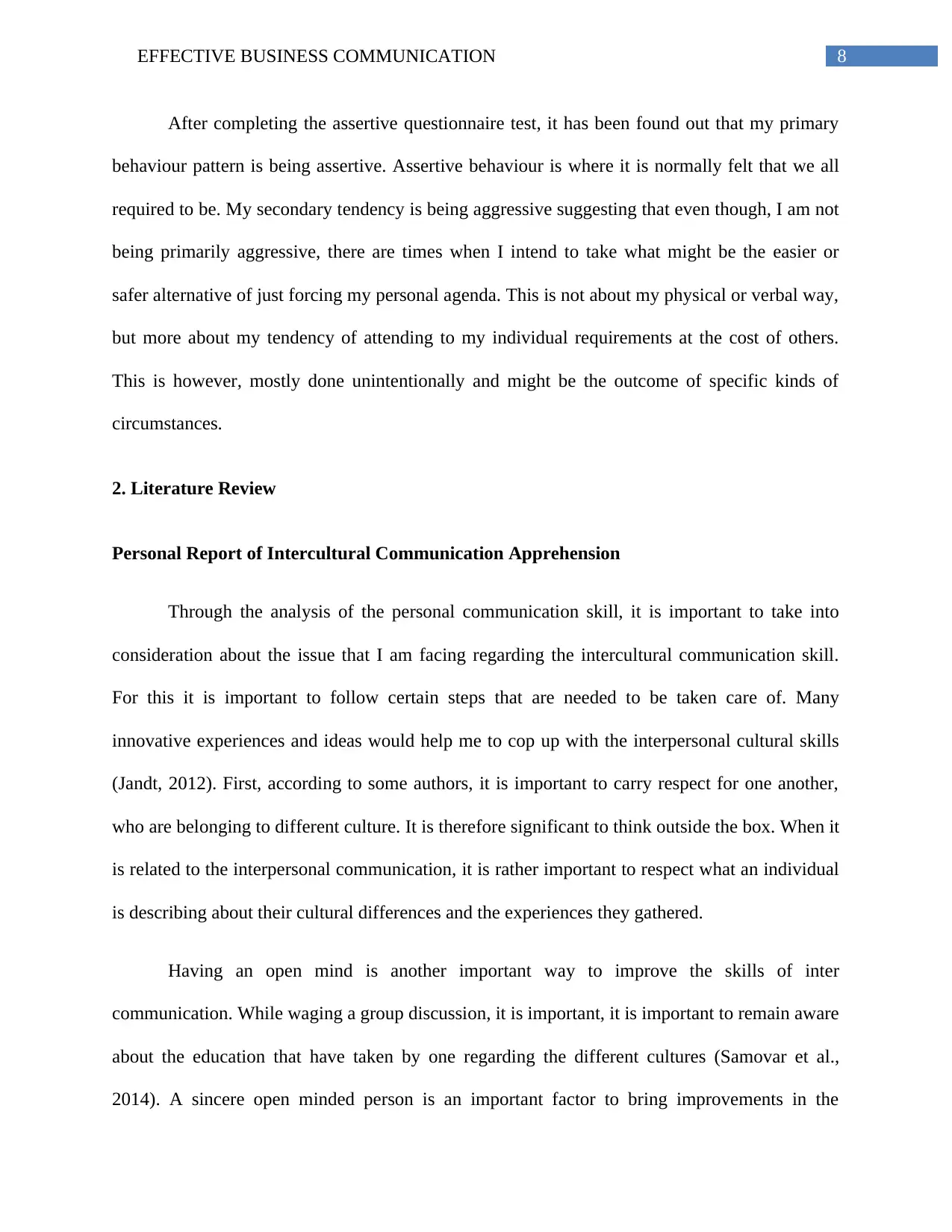
8EFFECTIVE BUSINESS COMMUNICATION
After completing the assertive questionnaire test, it has been found out that my primary
behaviour pattern is being assertive. Assertive behaviour is where it is normally felt that we all
required to be. My secondary tendency is being aggressive suggesting that even though, I am not
being primarily aggressive, there are times when I intend to take what might be the easier or
safer alternative of just forcing my personal agenda. This is not about my physical or verbal way,
but more about my tendency of attending to my individual requirements at the cost of others.
This is however, mostly done unintentionally and might be the outcome of specific kinds of
circumstances.
2. Literature Review
Personal Report of Intercultural Communication Apprehension
Through the analysis of the personal communication skill, it is important to take into
consideration about the issue that I am facing regarding the intercultural communication skill.
For this it is important to follow certain steps that are needed to be taken care of. Many
innovative experiences and ideas would help me to cop up with the interpersonal cultural skills
(Jandt, 2012). First, according to some authors, it is important to carry respect for one another,
who are belonging to different culture. It is therefore significant to think outside the box. When it
is related to the interpersonal communication, it is rather important to respect what an individual
is describing about their cultural differences and the experiences they gathered.
Having an open mind is another important way to improve the skills of inter
communication. While waging a group discussion, it is important, it is important to remain aware
about the education that have taken by one regarding the different cultures (Samovar et al.,
2014). A sincere open minded person is an important factor to bring improvements in the
After completing the assertive questionnaire test, it has been found out that my primary
behaviour pattern is being assertive. Assertive behaviour is where it is normally felt that we all
required to be. My secondary tendency is being aggressive suggesting that even though, I am not
being primarily aggressive, there are times when I intend to take what might be the easier or
safer alternative of just forcing my personal agenda. This is not about my physical or verbal way,
but more about my tendency of attending to my individual requirements at the cost of others.
This is however, mostly done unintentionally and might be the outcome of specific kinds of
circumstances.
2. Literature Review
Personal Report of Intercultural Communication Apprehension
Through the analysis of the personal communication skill, it is important to take into
consideration about the issue that I am facing regarding the intercultural communication skill.
For this it is important to follow certain steps that are needed to be taken care of. Many
innovative experiences and ideas would help me to cop up with the interpersonal cultural skills
(Jandt, 2012). First, according to some authors, it is important to carry respect for one another,
who are belonging to different culture. It is therefore significant to think outside the box. When it
is related to the interpersonal communication, it is rather important to respect what an individual
is describing about their cultural differences and the experiences they gathered.
Having an open mind is another important way to improve the skills of inter
communication. While waging a group discussion, it is important, it is important to remain aware
about the education that have taken by one regarding the different cultures (Samovar et al.,
2014). A sincere open minded person is an important factor to bring improvements in the
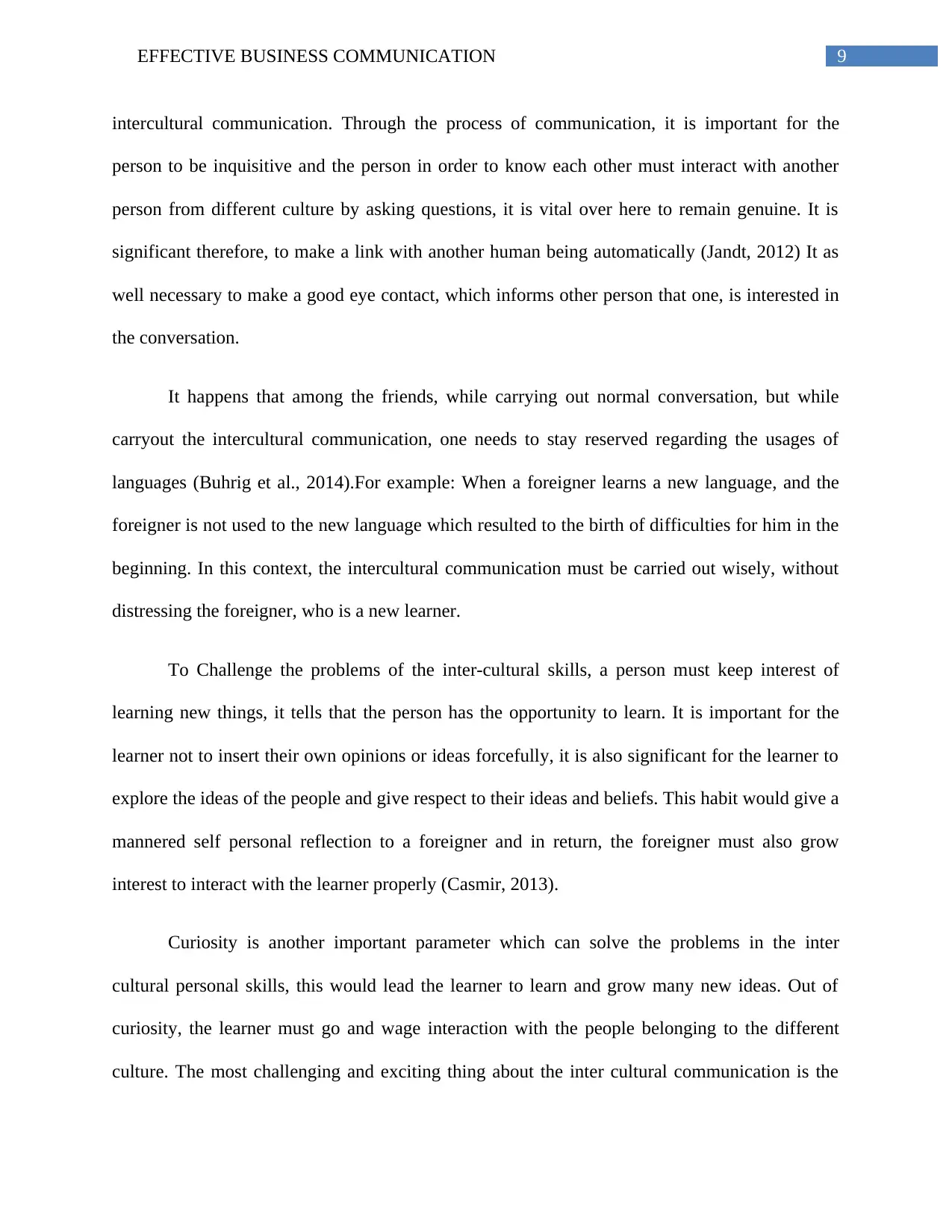
9EFFECTIVE BUSINESS COMMUNICATION
intercultural communication. Through the process of communication, it is important for the
person to be inquisitive and the person in order to know each other must interact with another
person from different culture by asking questions, it is vital over here to remain genuine. It is
significant therefore, to make a link with another human being automatically (Jandt, 2012) It as
well necessary to make a good eye contact, which informs other person that one, is interested in
the conversation.
It happens that among the friends, while carrying out normal conversation, but while
carryout the intercultural communication, one needs to stay reserved regarding the usages of
languages (Buhrig et al., 2014).For example: When a foreigner learns a new language, and the
foreigner is not used to the new language which resulted to the birth of difficulties for him in the
beginning. In this context, the intercultural communication must be carried out wisely, without
distressing the foreigner, who is a new learner.
To Challenge the problems of the inter-cultural skills, a person must keep interest of
learning new things, it tells that the person has the opportunity to learn. It is important for the
learner not to insert their own opinions or ideas forcefully, it is also significant for the learner to
explore the ideas of the people and give respect to their ideas and beliefs. This habit would give a
mannered self personal reflection to a foreigner and in return, the foreigner must also grow
interest to interact with the learner properly (Casmir, 2013).
Curiosity is another important parameter which can solve the problems in the inter
cultural personal skills, this would lead the learner to learn and grow many new ideas. Out of
curiosity, the learner must go and wage interaction with the people belonging to the different
culture. The most challenging and exciting thing about the inter cultural communication is the
intercultural communication. Through the process of communication, it is important for the
person to be inquisitive and the person in order to know each other must interact with another
person from different culture by asking questions, it is vital over here to remain genuine. It is
significant therefore, to make a link with another human being automatically (Jandt, 2012) It as
well necessary to make a good eye contact, which informs other person that one, is interested in
the conversation.
It happens that among the friends, while carrying out normal conversation, but while
carryout the intercultural communication, one needs to stay reserved regarding the usages of
languages (Buhrig et al., 2014).For example: When a foreigner learns a new language, and the
foreigner is not used to the new language which resulted to the birth of difficulties for him in the
beginning. In this context, the intercultural communication must be carried out wisely, without
distressing the foreigner, who is a new learner.
To Challenge the problems of the inter-cultural skills, a person must keep interest of
learning new things, it tells that the person has the opportunity to learn. It is important for the
learner not to insert their own opinions or ideas forcefully, it is also significant for the learner to
explore the ideas of the people and give respect to their ideas and beliefs. This habit would give a
mannered self personal reflection to a foreigner and in return, the foreigner must also grow
interest to interact with the learner properly (Casmir, 2013).
Curiosity is another important parameter which can solve the problems in the inter
cultural personal skills, this would lead the learner to learn and grow many new ideas. Out of
curiosity, the learner must go and wage interaction with the people belonging to the different
culture. The most challenging and exciting thing about the inter cultural communication is the
Secure Best Marks with AI Grader
Need help grading? Try our AI Grader for instant feedback on your assignments.
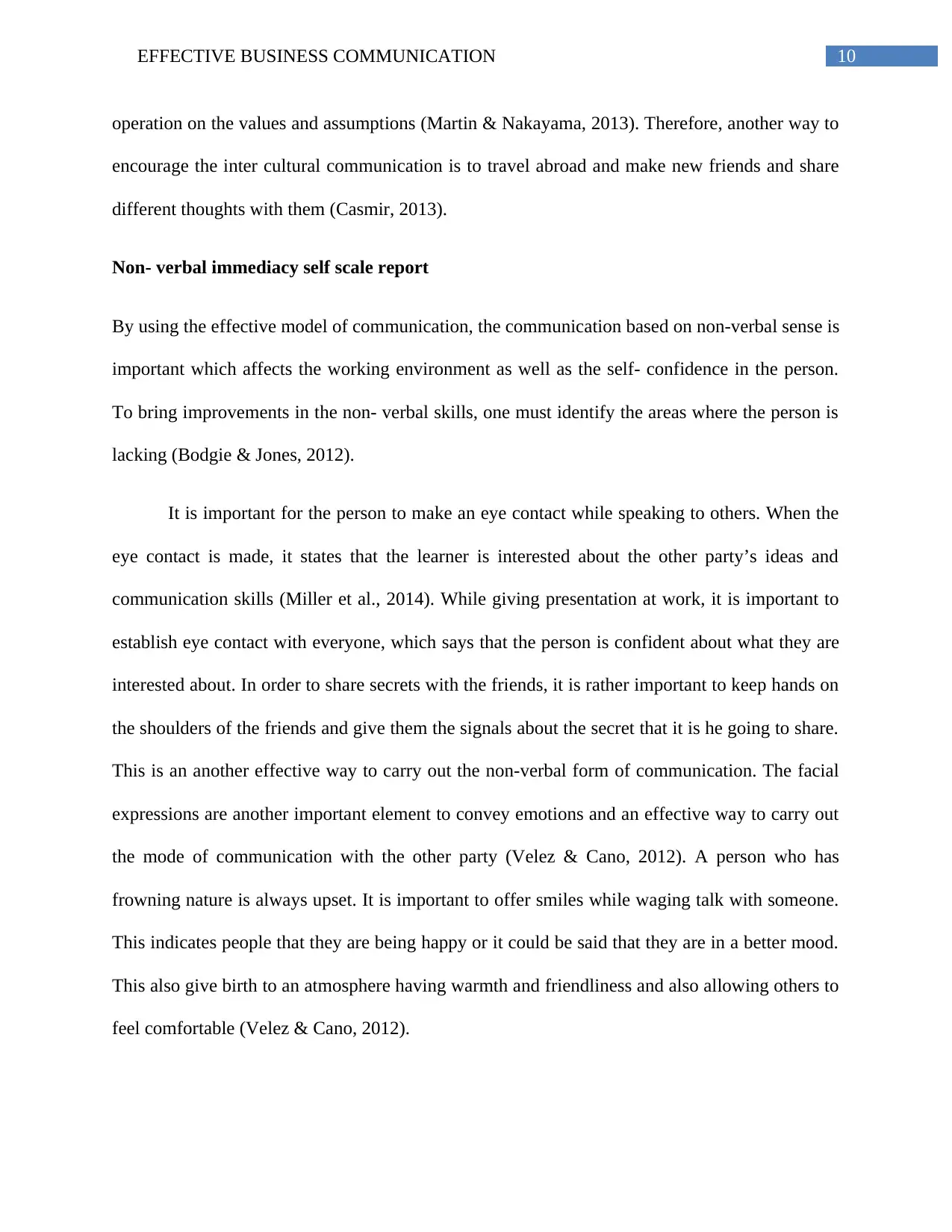
10EFFECTIVE BUSINESS COMMUNICATION
operation on the values and assumptions (Martin & Nakayama, 2013). Therefore, another way to
encourage the inter cultural communication is to travel abroad and make new friends and share
different thoughts with them (Casmir, 2013).
Non- verbal immediacy self scale report
By using the effective model of communication, the communication based on non-verbal sense is
important which affects the working environment as well as the self- confidence in the person.
To bring improvements in the non- verbal skills, one must identify the areas where the person is
lacking (Bodgie & Jones, 2012).
It is important for the person to make an eye contact while speaking to others. When the
eye contact is made, it states that the learner is interested about the other party’s ideas and
communication skills (Miller et al., 2014). While giving presentation at work, it is important to
establish eye contact with everyone, which says that the person is confident about what they are
interested about. In order to share secrets with the friends, it is rather important to keep hands on
the shoulders of the friends and give them the signals about the secret that it is he going to share.
This is an another effective way to carry out the non-verbal form of communication. The facial
expressions are another important element to convey emotions and an effective way to carry out
the mode of communication with the other party (Velez & Cano, 2012). A person who has
frowning nature is always upset. It is important to offer smiles while waging talk with someone.
This indicates people that they are being happy or it could be said that they are in a better mood.
This also give birth to an atmosphere having warmth and friendliness and also allowing others to
feel comfortable (Velez & Cano, 2012).
operation on the values and assumptions (Martin & Nakayama, 2013). Therefore, another way to
encourage the inter cultural communication is to travel abroad and make new friends and share
different thoughts with them (Casmir, 2013).
Non- verbal immediacy self scale report
By using the effective model of communication, the communication based on non-verbal sense is
important which affects the working environment as well as the self- confidence in the person.
To bring improvements in the non- verbal skills, one must identify the areas where the person is
lacking (Bodgie & Jones, 2012).
It is important for the person to make an eye contact while speaking to others. When the
eye contact is made, it states that the learner is interested about the other party’s ideas and
communication skills (Miller et al., 2014). While giving presentation at work, it is important to
establish eye contact with everyone, which says that the person is confident about what they are
interested about. In order to share secrets with the friends, it is rather important to keep hands on
the shoulders of the friends and give them the signals about the secret that it is he going to share.
This is an another effective way to carry out the non-verbal form of communication. The facial
expressions are another important element to convey emotions and an effective way to carry out
the mode of communication with the other party (Velez & Cano, 2012). A person who has
frowning nature is always upset. It is important to offer smiles while waging talk with someone.
This indicates people that they are being happy or it could be said that they are in a better mood.
This also give birth to an atmosphere having warmth and friendliness and also allowing others to
feel comfortable (Velez & Cano, 2012).
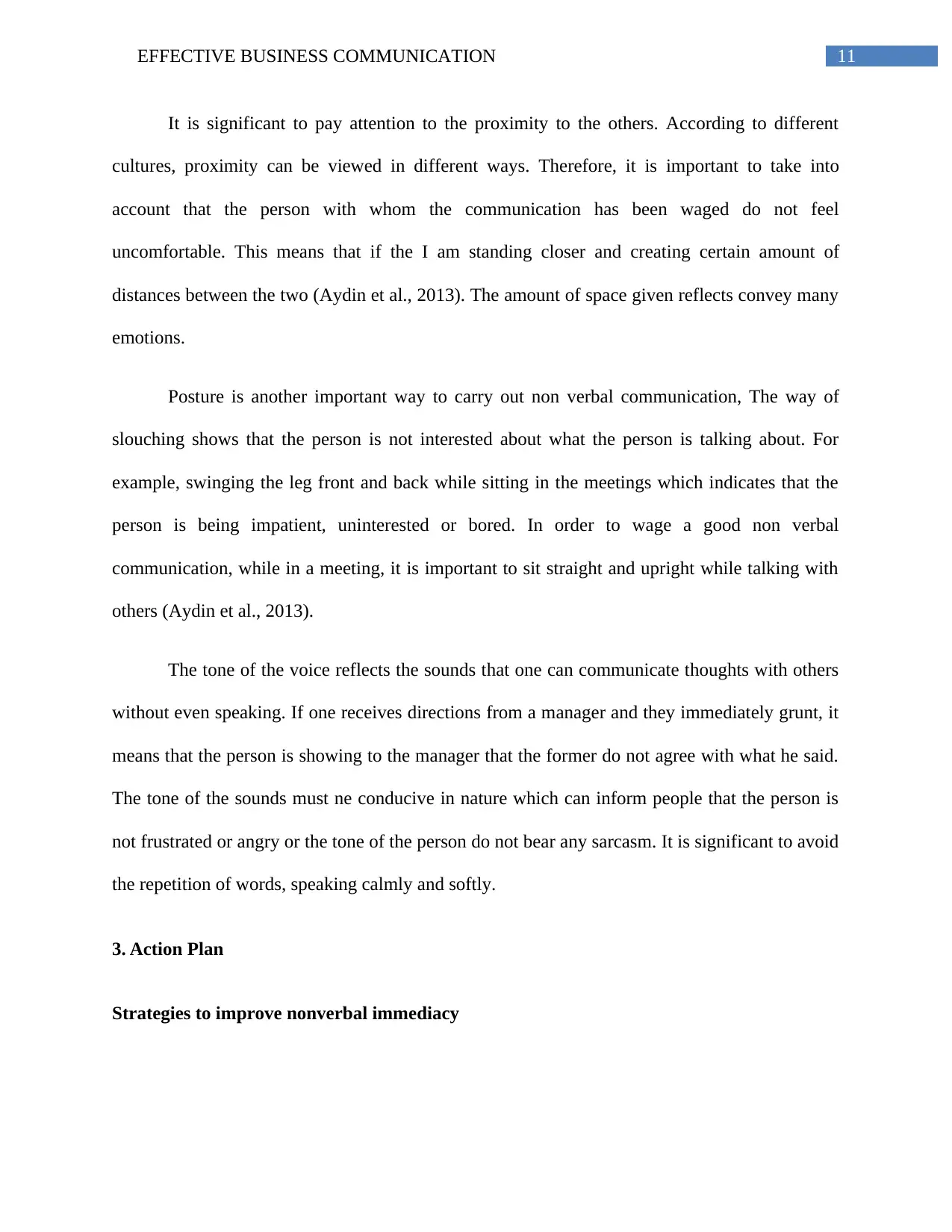
11EFFECTIVE BUSINESS COMMUNICATION
It is significant to pay attention to the proximity to the others. According to different
cultures, proximity can be viewed in different ways. Therefore, it is important to take into
account that the person with whom the communication has been waged do not feel
uncomfortable. This means that if the I am standing closer and creating certain amount of
distances between the two (Aydin et al., 2013). The amount of space given reflects convey many
emotions.
Posture is another important way to carry out non verbal communication, The way of
slouching shows that the person is not interested about what the person is talking about. For
example, swinging the leg front and back while sitting in the meetings which indicates that the
person is being impatient, uninterested or bored. In order to wage a good non verbal
communication, while in a meeting, it is important to sit straight and upright while talking with
others (Aydin et al., 2013).
The tone of the voice reflects the sounds that one can communicate thoughts with others
without even speaking. If one receives directions from a manager and they immediately grunt, it
means that the person is showing to the manager that the former do not agree with what he said.
The tone of the sounds must ne conducive in nature which can inform people that the person is
not frustrated or angry or the tone of the person do not bear any sarcasm. It is significant to avoid
the repetition of words, speaking calmly and softly.
3. Action Plan
Strategies to improve nonverbal immediacy
It is significant to pay attention to the proximity to the others. According to different
cultures, proximity can be viewed in different ways. Therefore, it is important to take into
account that the person with whom the communication has been waged do not feel
uncomfortable. This means that if the I am standing closer and creating certain amount of
distances between the two (Aydin et al., 2013). The amount of space given reflects convey many
emotions.
Posture is another important way to carry out non verbal communication, The way of
slouching shows that the person is not interested about what the person is talking about. For
example, swinging the leg front and back while sitting in the meetings which indicates that the
person is being impatient, uninterested or bored. In order to wage a good non verbal
communication, while in a meeting, it is important to sit straight and upright while talking with
others (Aydin et al., 2013).
The tone of the voice reflects the sounds that one can communicate thoughts with others
without even speaking. If one receives directions from a manager and they immediately grunt, it
means that the person is showing to the manager that the former do not agree with what he said.
The tone of the sounds must ne conducive in nature which can inform people that the person is
not frustrated or angry or the tone of the person do not bear any sarcasm. It is significant to avoid
the repetition of words, speaking calmly and softly.
3. Action Plan
Strategies to improve nonverbal immediacy
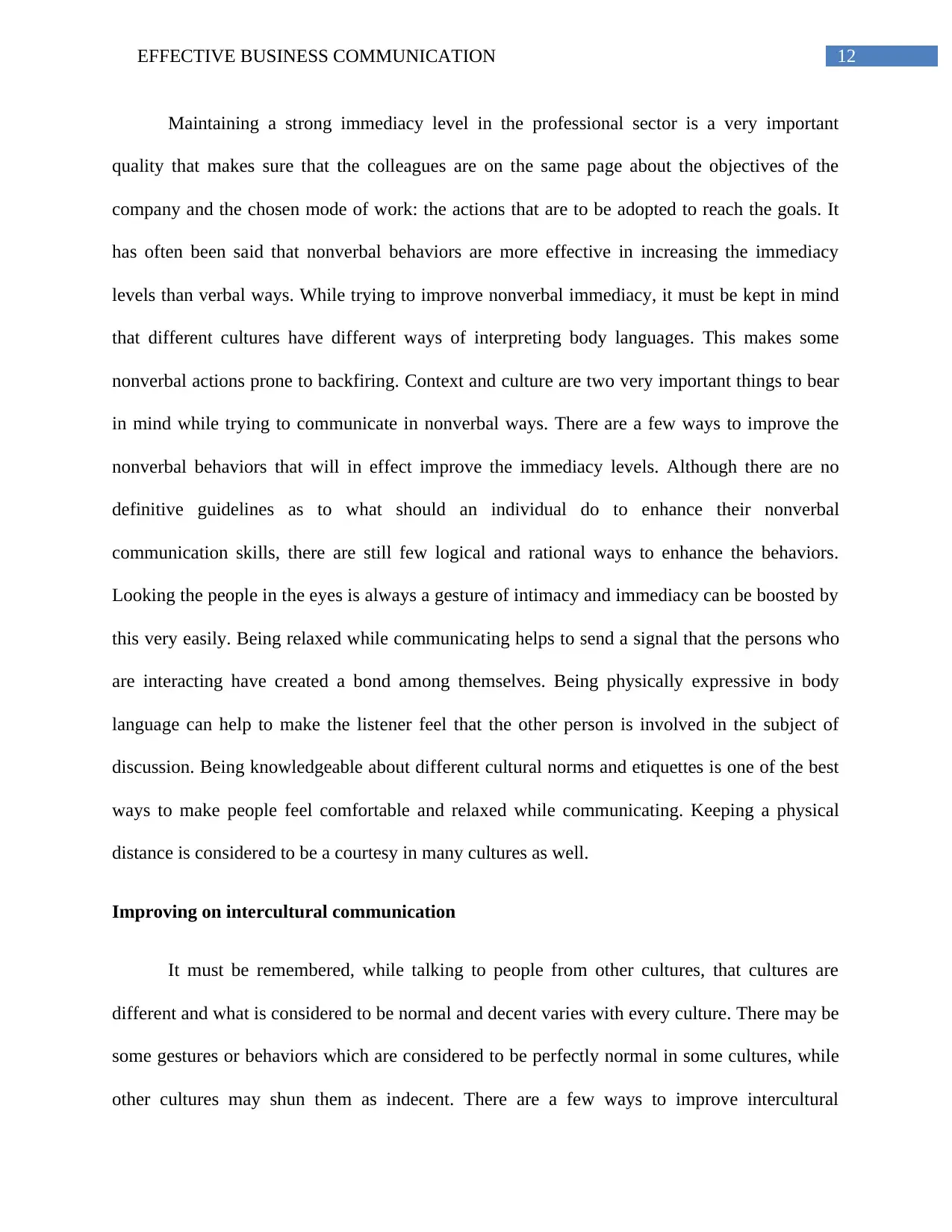
12EFFECTIVE BUSINESS COMMUNICATION
Maintaining a strong immediacy level in the professional sector is a very important
quality that makes sure that the colleagues are on the same page about the objectives of the
company and the chosen mode of work: the actions that are to be adopted to reach the goals. It
has often been said that nonverbal behaviors are more effective in increasing the immediacy
levels than verbal ways. While trying to improve nonverbal immediacy, it must be kept in mind
that different cultures have different ways of interpreting body languages. This makes some
nonverbal actions prone to backfiring. Context and culture are two very important things to bear
in mind while trying to communicate in nonverbal ways. There are a few ways to improve the
nonverbal behaviors that will in effect improve the immediacy levels. Although there are no
definitive guidelines as to what should an individual do to enhance their nonverbal
communication skills, there are still few logical and rational ways to enhance the behaviors.
Looking the people in the eyes is always a gesture of intimacy and immediacy can be boosted by
this very easily. Being relaxed while communicating helps to send a signal that the persons who
are interacting have created a bond among themselves. Being physically expressive in body
language can help to make the listener feel that the other person is involved in the subject of
discussion. Being knowledgeable about different cultural norms and etiquettes is one of the best
ways to make people feel comfortable and relaxed while communicating. Keeping a physical
distance is considered to be a courtesy in many cultures as well.
Improving on intercultural communication
It must be remembered, while talking to people from other cultures, that cultures are
different and what is considered to be normal and decent varies with every culture. There may be
some gestures or behaviors which are considered to be perfectly normal in some cultures, while
other cultures may shun them as indecent. There are a few ways to improve intercultural
Maintaining a strong immediacy level in the professional sector is a very important
quality that makes sure that the colleagues are on the same page about the objectives of the
company and the chosen mode of work: the actions that are to be adopted to reach the goals. It
has often been said that nonverbal behaviors are more effective in increasing the immediacy
levels than verbal ways. While trying to improve nonverbal immediacy, it must be kept in mind
that different cultures have different ways of interpreting body languages. This makes some
nonverbal actions prone to backfiring. Context and culture are two very important things to bear
in mind while trying to communicate in nonverbal ways. There are a few ways to improve the
nonverbal behaviors that will in effect improve the immediacy levels. Although there are no
definitive guidelines as to what should an individual do to enhance their nonverbal
communication skills, there are still few logical and rational ways to enhance the behaviors.
Looking the people in the eyes is always a gesture of intimacy and immediacy can be boosted by
this very easily. Being relaxed while communicating helps to send a signal that the persons who
are interacting have created a bond among themselves. Being physically expressive in body
language can help to make the listener feel that the other person is involved in the subject of
discussion. Being knowledgeable about different cultural norms and etiquettes is one of the best
ways to make people feel comfortable and relaxed while communicating. Keeping a physical
distance is considered to be a courtesy in many cultures as well.
Improving on intercultural communication
It must be remembered, while talking to people from other cultures, that cultures are
different and what is considered to be normal and decent varies with every culture. There may be
some gestures or behaviors which are considered to be perfectly normal in some cultures, while
other cultures may shun them as indecent. There are a few ways to improve intercultural
Paraphrase This Document
Need a fresh take? Get an instant paraphrase of this document with our AI Paraphraser
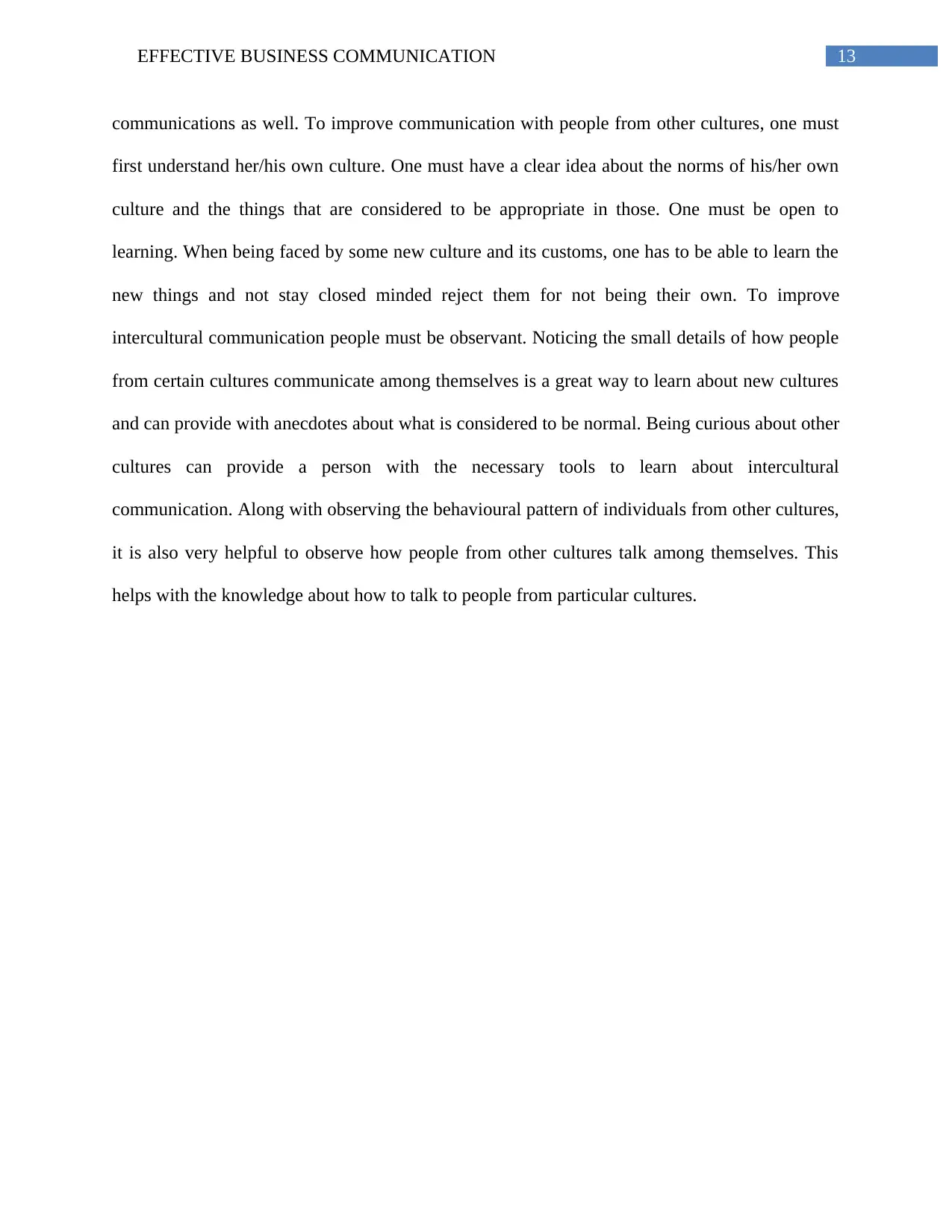
13EFFECTIVE BUSINESS COMMUNICATION
communications as well. To improve communication with people from other cultures, one must
first understand her/his own culture. One must have a clear idea about the norms of his/her own
culture and the things that are considered to be appropriate in those. One must be open to
learning. When being faced by some new culture and its customs, one has to be able to learn the
new things and not stay closed minded reject them for not being their own. To improve
intercultural communication people must be observant. Noticing the small details of how people
from certain cultures communicate among themselves is a great way to learn about new cultures
and can provide with anecdotes about what is considered to be normal. Being curious about other
cultures can provide a person with the necessary tools to learn about intercultural
communication. Along with observing the behavioural pattern of individuals from other cultures,
it is also very helpful to observe how people from other cultures talk among themselves. This
helps with the knowledge about how to talk to people from particular cultures.
communications as well. To improve communication with people from other cultures, one must
first understand her/his own culture. One must have a clear idea about the norms of his/her own
culture and the things that are considered to be appropriate in those. One must be open to
learning. When being faced by some new culture and its customs, one has to be able to learn the
new things and not stay closed minded reject them for not being their own. To improve
intercultural communication people must be observant. Noticing the small details of how people
from certain cultures communicate among themselves is a great way to learn about new cultures
and can provide with anecdotes about what is considered to be normal. Being curious about other
cultures can provide a person with the necessary tools to learn about intercultural
communication. Along with observing the behavioural pattern of individuals from other cultures,
it is also very helpful to observe how people from other cultures talk among themselves. This
helps with the knowledge about how to talk to people from particular cultures.
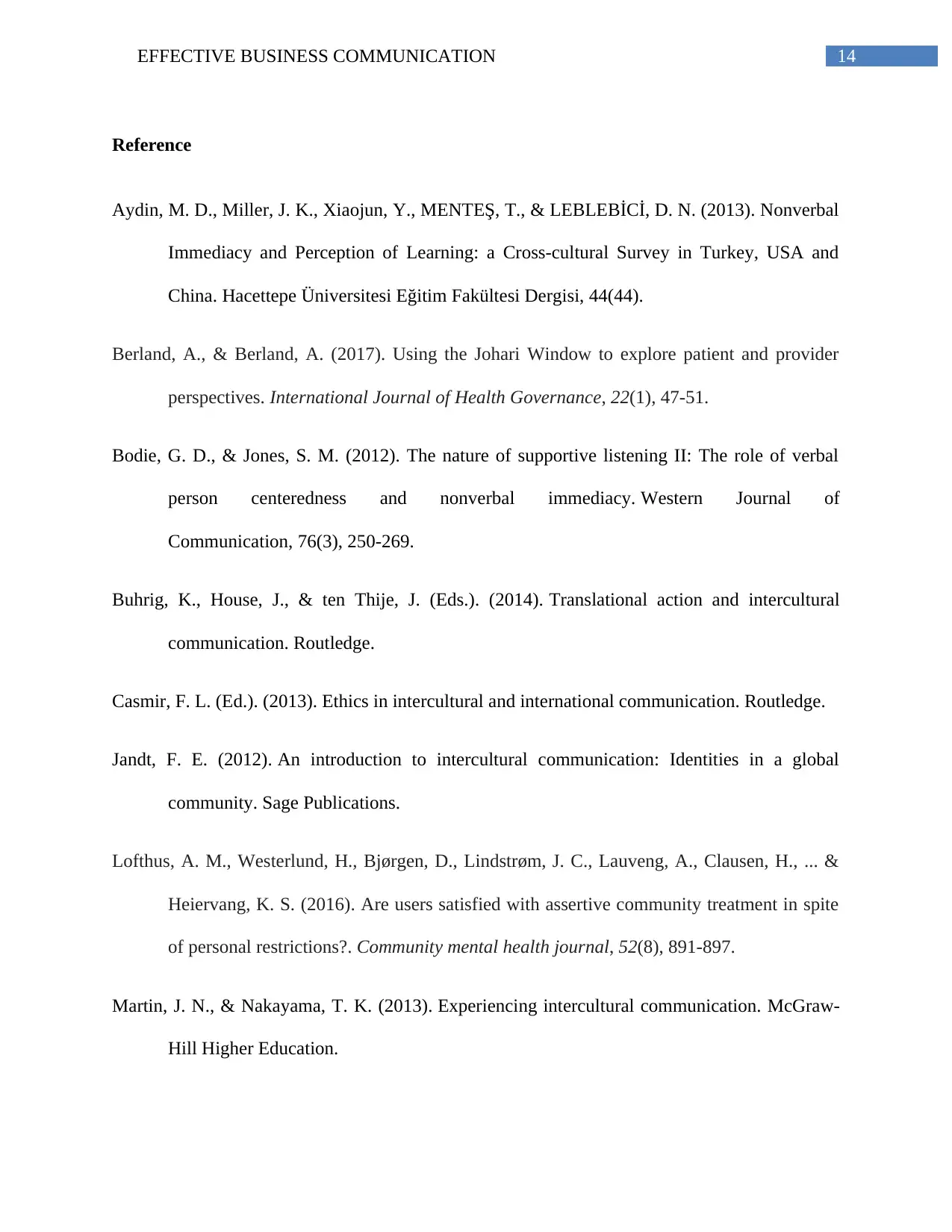
14EFFECTIVE BUSINESS COMMUNICATION
Reference
Aydin, M. D., Miller, J. K., Xiaojun, Y., MENTEŞ, T., & LEBLEBİCİ, D. N. (2013). Nonverbal
Immediacy and Perception of Learning: a Cross-cultural Survey in Turkey, USA and
China. Hacettepe Üniversitesi Eğitim Fakültesi Dergisi, 44(44).
Berland, A., & Berland, A. (2017). Using the Johari Window to explore patient and provider
perspectives. International Journal of Health Governance, 22(1), 47-51.
Bodie, G. D., & Jones, S. M. (2012). The nature of supportive listening II: The role of verbal
person centeredness and nonverbal immediacy. Western Journal of
Communication, 76(3), 250-269.
Buhrig, K., House, J., & ten Thije, J. (Eds.). (2014). Translational action and intercultural
communication. Routledge.
Casmir, F. L. (Ed.). (2013). Ethics in intercultural and international communication. Routledge.
Jandt, F. E. (2012). An introduction to intercultural communication: Identities in a global
community. Sage Publications.
Lofthus, A. M., Westerlund, H., Bjørgen, D., Lindstrøm, J. C., Lauveng, A., Clausen, H., ... &
Heiervang, K. S. (2016). Are users satisfied with assertive community treatment in spite
of personal restrictions?. Community mental health journal, 52(8), 891-897.
Martin, J. N., & Nakayama, T. K. (2013). Experiencing intercultural communication. McGraw-
Hill Higher Education.
Reference
Aydin, M. D., Miller, J. K., Xiaojun, Y., MENTEŞ, T., & LEBLEBİCİ, D. N. (2013). Nonverbal
Immediacy and Perception of Learning: a Cross-cultural Survey in Turkey, USA and
China. Hacettepe Üniversitesi Eğitim Fakültesi Dergisi, 44(44).
Berland, A., & Berland, A. (2017). Using the Johari Window to explore patient and provider
perspectives. International Journal of Health Governance, 22(1), 47-51.
Bodie, G. D., & Jones, S. M. (2012). The nature of supportive listening II: The role of verbal
person centeredness and nonverbal immediacy. Western Journal of
Communication, 76(3), 250-269.
Buhrig, K., House, J., & ten Thije, J. (Eds.). (2014). Translational action and intercultural
communication. Routledge.
Casmir, F. L. (Ed.). (2013). Ethics in intercultural and international communication. Routledge.
Jandt, F. E. (2012). An introduction to intercultural communication: Identities in a global
community. Sage Publications.
Lofthus, A. M., Westerlund, H., Bjørgen, D., Lindstrøm, J. C., Lauveng, A., Clausen, H., ... &
Heiervang, K. S. (2016). Are users satisfied with assertive community treatment in spite
of personal restrictions?. Community mental health journal, 52(8), 891-897.
Martin, J. N., & Nakayama, T. K. (2013). Experiencing intercultural communication. McGraw-
Hill Higher Education.
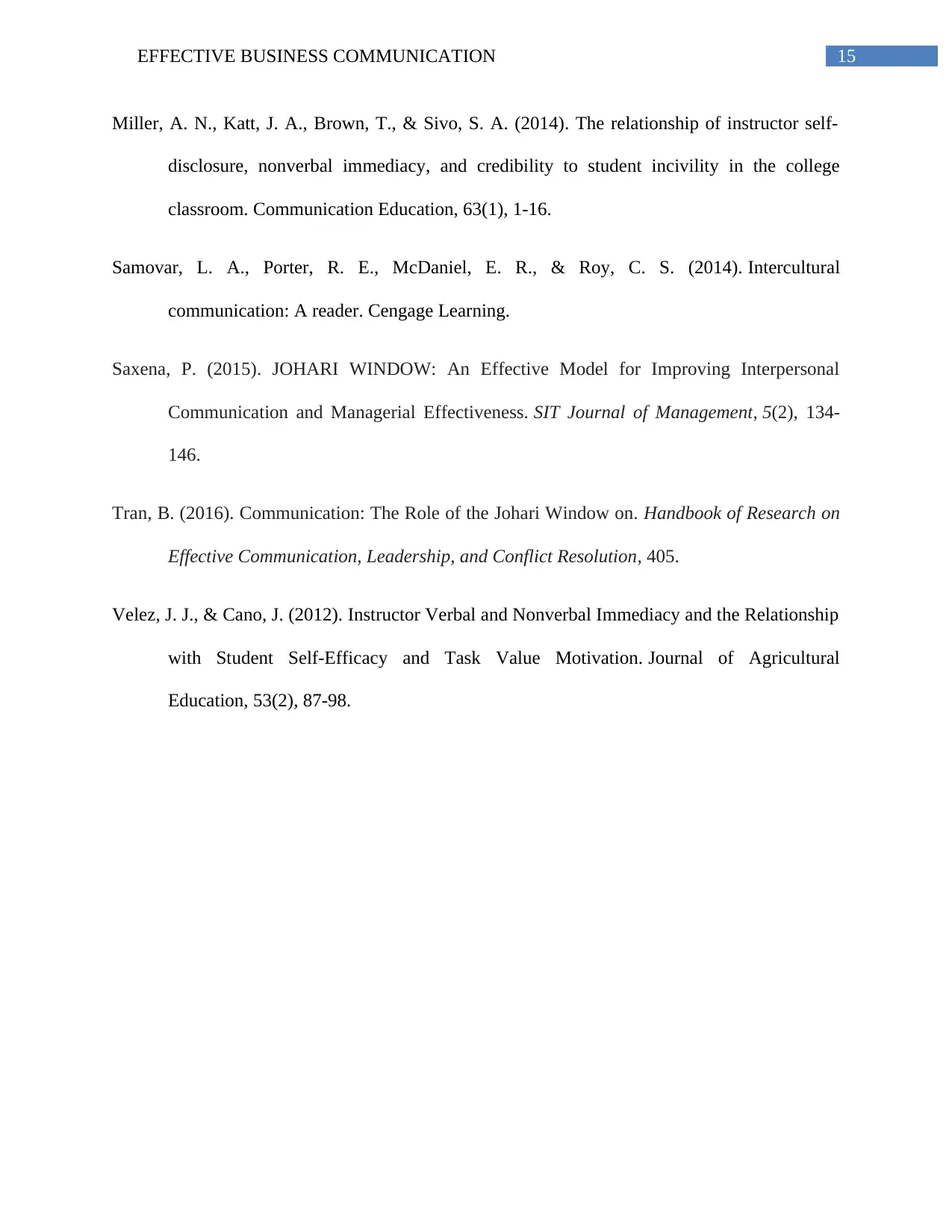
15EFFECTIVE BUSINESS COMMUNICATION
Miller, A. N., Katt, J. A., Brown, T., & Sivo, S. A. (2014). The relationship of instructor self-
disclosure, nonverbal immediacy, and credibility to student incivility in the college
classroom. Communication Education, 63(1), 1-16.
Samovar, L. A., Porter, R. E., McDaniel, E. R., & Roy, C. S. (2014). Intercultural
communication: A reader. Cengage Learning.
Saxena, P. (2015). JOHARI WINDOW: An Effective Model for Improving Interpersonal
Communication and Managerial Effectiveness. SIT Journal of Management, 5(2), 134-
146.
Tran, B. (2016). Communication: The Role of the Johari Window on. Handbook of Research on
Effective Communication, Leadership, and Conflict Resolution, 405.
Velez, J. J., & Cano, J. (2012). Instructor Verbal and Nonverbal Immediacy and the Relationship
with Student Self-Efficacy and Task Value Motivation. Journal of Agricultural
Education, 53(2), 87-98.
Miller, A. N., Katt, J. A., Brown, T., & Sivo, S. A. (2014). The relationship of instructor self-
disclosure, nonverbal immediacy, and credibility to student incivility in the college
classroom. Communication Education, 63(1), 1-16.
Samovar, L. A., Porter, R. E., McDaniel, E. R., & Roy, C. S. (2014). Intercultural
communication: A reader. Cengage Learning.
Saxena, P. (2015). JOHARI WINDOW: An Effective Model for Improving Interpersonal
Communication and Managerial Effectiveness. SIT Journal of Management, 5(2), 134-
146.
Tran, B. (2016). Communication: The Role of the Johari Window on. Handbook of Research on
Effective Communication, Leadership, and Conflict Resolution, 405.
Velez, J. J., & Cano, J. (2012). Instructor Verbal and Nonverbal Immediacy and the Relationship
with Student Self-Efficacy and Task Value Motivation. Journal of Agricultural
Education, 53(2), 87-98.
1 out of 16
Related Documents
Your All-in-One AI-Powered Toolkit for Academic Success.
+13062052269
info@desklib.com
Available 24*7 on WhatsApp / Email
![[object Object]](/_next/static/media/star-bottom.7253800d.svg)
Unlock your academic potential
© 2024 | Zucol Services PVT LTD | All rights reserved.





